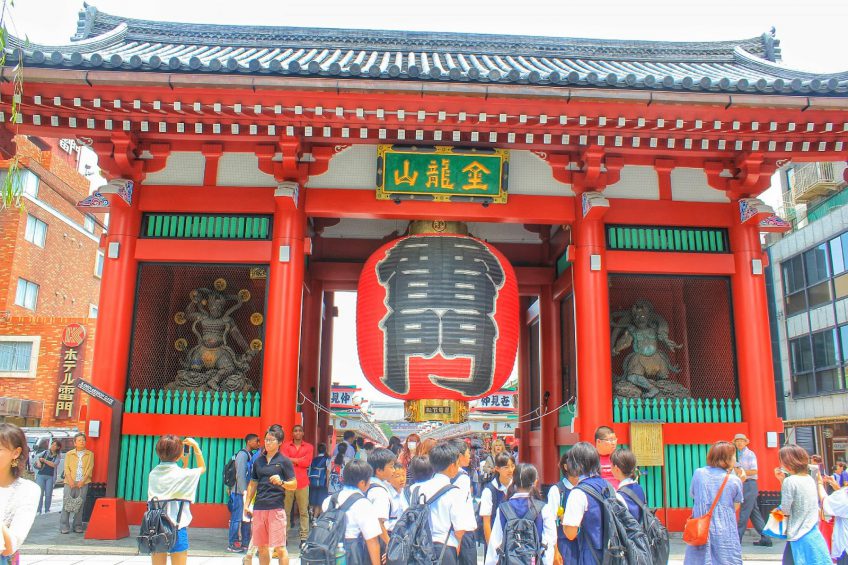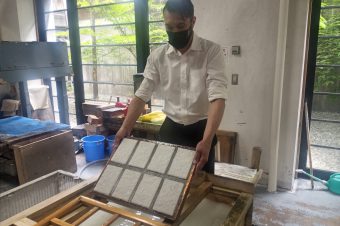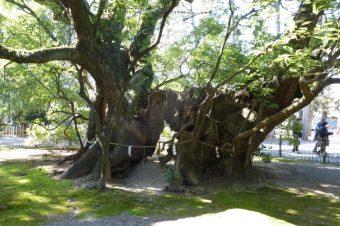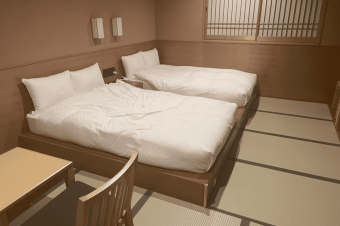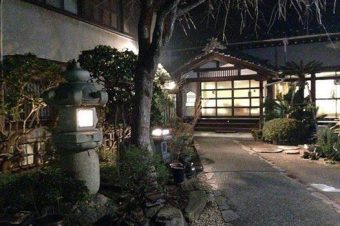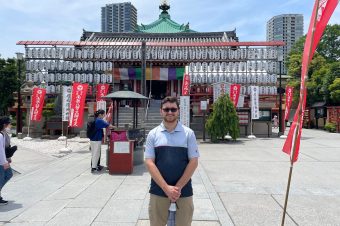Located in Asakusa, part of Taito-ku, Tokyo, lies Sensō-ji, the oldest temple in Tokyo. Sensō-ji is a Buddhist temple that is currently one of the most popular places to visit in Tokyo with over 30 million visitors a year. Just take one look at the temple and it’s not too hard to see why. Consisting of 8 temple buildings and over 80 small shops covering over half a mile it’s easy to find yourself 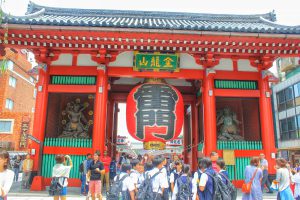 getting lost in the busyness and beauty of Sensō-ji . Here is a guide 5 things you need to see when visiting the Sensō-ji Temple grounds.
getting lost in the busyness and beauty of Sensō-ji . Here is a guide 5 things you need to see when visiting the Sensō-ji Temple grounds.
- The Kaminarimon Gate: if you’re getting off the train at the Asakusa station, chances are the Kaminarimon Gate is going to be the first part of Sensō-ji you see. The Kaminarimon, or “Thunder Gate”, serves as the official entrance to the Sensō-ji Temple grounds and is the outer gate of the temple. It was originally built in 942 by military commander Taira no Kinmasa. The gate has two protector deities: Fujin, the god of wind, is on the right; Raijin, the god of thunder, is on the left. The structure features a massive red and black paper lantern, painted to suggest thunderclouds and lightening, hence the name. The traditional lantern called chochin in Japanese is 3.9 meters high, 3.3 meters in diameter and 700 kg in weight. The original lantern along with the original Kaminarimon were destroyed by a fire in 1865. However they were both rebuilt in 1960 and are
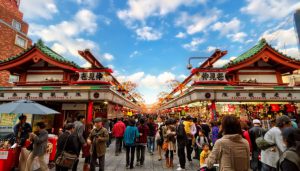 often considered the symbol of Sensō-ji. This is a great place to take photos and just take a moment to take in the amazing details of the lantern.
often considered the symbol of Sensō-ji. This is a great place to take photos and just take a moment to take in the amazing details of the lantern.
2. Nakamise-dori: The first thing you see as you pass through the Kaminarimon Gate is the Nakamise-dori. The Nakamise-dori is a 200 meter long street containing over 80 small shops. These shops sell just about anything you can imagine and are a great place to pick up souvenirs or a quick snack. I highly recommend picking up a paper lantern and some taiyaki (waffles filled with a sweat bean paste). This is often one of the busiest sections of the Sensō-ji temple, to avoid these crowds as much as possible I recommend going there on a weekday or getting there a little before the shops open around 10 am.
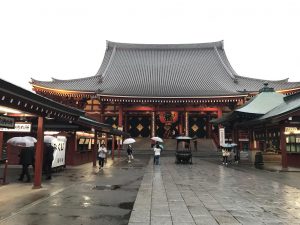 3.The Hondo (main hall): The Hondo Main Hall houses the Kannon image, which is away from view, deep inside the hall. It is a national treasure and was originally built in 942, but later rebuilt in 1958. One of the major key features of the Hondo is its distinctive sloping roof, which is taller than most temples, this allows the temple to be seen from a great distance. Before entering the hall make sure you buy Omikuji (paper fortune) for 100 yen. It is a lot of fun – simply drop 100 yen into the slots by the wooden drawers at either side of the approach to the hall. Pick up a silver canister, give it a shake, and take out a stick, which has a number in kanji on it. Replace the stick and find the corresponding drawer with your number on it. You can take your paper fortune out of the drawer and celebrate if you have found a lucky one. No matter if you haven’t, just tie the paper on the nearby rack, which is set up for accepting bad luck Omikuji. I also recommending stopping by the shop before you enter and picking up a Goshuin.
3.The Hondo (main hall): The Hondo Main Hall houses the Kannon image, which is away from view, deep inside the hall. It is a national treasure and was originally built in 942, but later rebuilt in 1958. One of the major key features of the Hondo is its distinctive sloping roof, which is taller than most temples, this allows the temple to be seen from a great distance. Before entering the hall make sure you buy Omikuji (paper fortune) for 100 yen. It is a lot of fun – simply drop 100 yen into the slots by the wooden drawers at either side of the approach to the hall. Pick up a silver canister, give it a shake, and take out a stick, which has a number in kanji on it. Replace the stick and find the corresponding drawer with your number on it. You can take your paper fortune out of the drawer and celebrate if you have found a lucky one. No matter if you haven’t, just tie the paper on the nearby rack, which is set up for accepting bad luck Omikuji. I also recommending stopping by the shop before you enter and picking up a Goshuin.
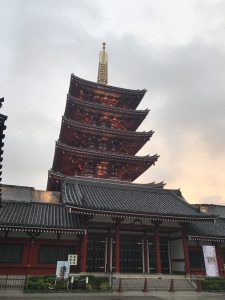 4.Five Story Pagoda: The Five-storied Pagoda the second highest pagoda in Japan. The pagoda was originally built in 942 it was then destroyed by fire and reconstructed in 1648. It holds Buddha’s ashes, given by Sri Lanka government and Buddhist society for goodwill between Sri Lanka and Japan, in its top floor. This pagoda is truly a sight to behold and is a must see and it is a fantastic place for pictures.
4.Five Story Pagoda: The Five-storied Pagoda the second highest pagoda in Japan. The pagoda was originally built in 942 it was then destroyed by fire and reconstructed in 1648. It holds Buddha’s ashes, given by Sri Lanka government and Buddhist society for goodwill between Sri Lanka and Japan, in its top floor. This pagoda is truly a sight to behold and is a must see and it is a fantastic place for pictures.
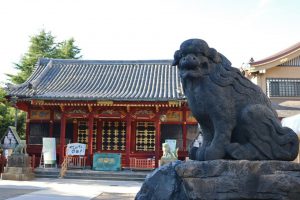 5. Asakusa Shrine: Off to the left of the main hall is the Asakusa Shrine. With so many buildings and things to see, it’s easy to miss the Asakusa Shrine. The shrine is dedicated to Ebisu, one of the Seven Gods of Good Luck. Built in 1649 , it has survived a number of fires over its 360-year history. It is designated a National Important Cultural Property by the Japanese government. Visitors who come on holidays during the spring and fall are also welcome to enjoy a special cup of tea prepared in a traditional tea ceremony and served by geisha. Traditional Shinto-style wedding ceremonies held in the solemn atmosphere of this cultural heritage have become increasingly popular over the years. Keep an eye out on the rickshaws, because there’s a good chance you’ll see a bride on the way to Asakusa Shrine, another part of Asakusa’s charm.
5. Asakusa Shrine: Off to the left of the main hall is the Asakusa Shrine. With so many buildings and things to see, it’s easy to miss the Asakusa Shrine. The shrine is dedicated to Ebisu, one of the Seven Gods of Good Luck. Built in 1649 , it has survived a number of fires over its 360-year history. It is designated a National Important Cultural Property by the Japanese government. Visitors who come on holidays during the spring and fall are also welcome to enjoy a special cup of tea prepared in a traditional tea ceremony and served by geisha. Traditional Shinto-style wedding ceremonies held in the solemn atmosphere of this cultural heritage have become increasingly popular over the years. Keep an eye out on the rickshaws, because there’s a good chance you’ll see a bride on the way to Asakusa Shrine, another part of Asakusa’s charm.
